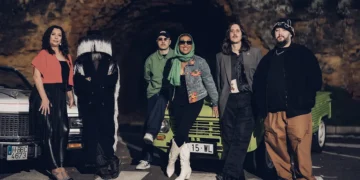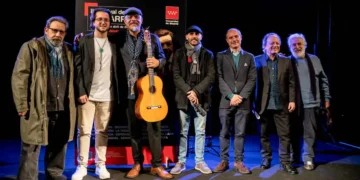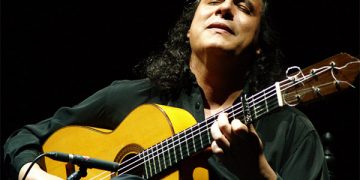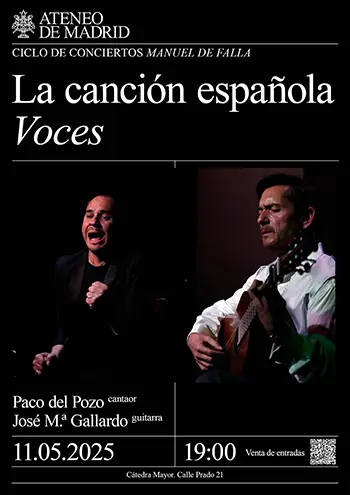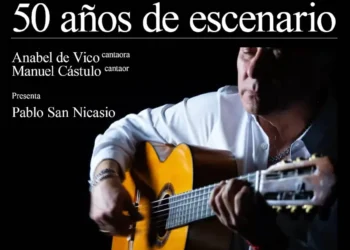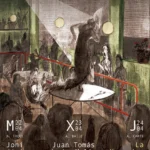|
3 FESTIVAL SUMA FLAMENCA
|
|
HOMENAJE A SABICAS, GERARDO NÚÑEZ Y GRUPO SABICAS AND CURED HAM When you stroll through the quiet streets of Granada’s Albaycín district, with its rippling water, rustling leaves, and the scent of delicate flowers from lovely balconies, you end up in a little plaza where you can sit peacefully and take in all the beauty. You can also sample the tapas the city is famous for, including the popular broad beans with ham, “habicas con jamón”. Agustín Castellón, known artistically as Sabicas, would have been a hundred years old last year. Flamenco history says that boy born in Pamplona, but artistically formed in old Madrid, loved habicas, and that’s how he got his nickname. Since history is written in books and encyclopedias, we have to respect it, but the fact is in the north of the peninsula there is no tradition of eating broad beans, one of the most famous plates of east Andalusian cuisine. These beans are so famous, there’s a story about an old lady who used to sell them, which led to the form “jaberas”. Don’t think you’re reading a tourist’s gastronomical guide, we’re actually talking about the shows offered last night at the Albéniz Theater in Madrid, within the program of Suma Flamenca. Years ago José Luis Ortiz Nuevo wondered if anything was known about flamenco, and there is clearly a lot to be found out, because the Sabicas centennial passed unnoticed and only Gerardo Núñez had the good sense to remember the maestro. What’s interesting too, is that Gerardo, though from Jerez, has links to Granada, although we don’t know if he like “habicas”. The show opened with Sabicas’ alegrías, with the same elegance he was famous for, not only in his playing, but appearance as well, projected in a video that was recorded with the illustrious Granada man Enrique Morente when he returned to Spain in the eartly eighties. Next, it was Gerardo’s turn. He interpreted Granados’ Danza Española to bulerías, before ceding the stage to the young boy from Cáceres who continues to demonstrate how unfair life can be when he didn’t receive any prize in the last Córdoba contest. We’re talking about Javier Conde who played a brilliant soleá and zapateado with tarantella airs. Then, Granada again, with the guitar of Miguel Ochando, another very talented guitarist. He seduced us with his siguiriyas, and the rondeña evoked Sabicas’ mentor, Don Ramón Montoya. Quoting the King Midas of flamenco, it was Núñez, Conde and Ochando, quintessential guitar-playing. The same elegance he was famous for, not only in his playing, but his appearance as well The rest of the group appeared, with Jesús Méndez and Rafael de Utrera singing, the subtle percussion of Cepillo and the dancing of Carmen Cortés. Bulerías pa’ escuchar (soleá por bulería) with the aroma of Jerez taverns, the street-vendor’s cante of Macandé ended with tonás by Méndez and a dense soleá by Carmen Cortés who offered her own particular tribute to Sabicas remembering Carmen Amaya who had shared so many stages with the guitarist. More Granada references from families who eventually settled in Barcelona, so it’s no surprise their dancing incorporates steps and movements from the bolero style as seen in the caves of Sacromonte as the “cachucha” or the “mosca”. A traditional fiesta finale included Cepillo’s cante and the bulerías dance of Jesús Méndez. After intermission, it was Esperanza Fernández with the debut of her show based on the record “Recuerdos”. This represents a quantum leap in staging for the Triana singer, but her cantes were the same as always. One novelty was the bulerías song “Manuel Reyes”, formerly popularized by Niña de los Peines, and the moving Gelem Gelem, the gypsy anthem used to close the show and intended to raise consciousness regarding the history of this ethnic group which has suffered persecution from the times of Ferdinand and Isabelle, right up to Hitler’s Reich. Tangos, farruca, fandangos de Lucena, soleá de Alcalá and siguiriyas. The collaboration of guitarists Miguel Ángel Cortés and Salvador Gutiérrez was noteworthy. Dancer Miguel Vargas put his grain of sand, and Agustín Diaserra’s percussion rounded out the group. To wind up the evening we went to a 21st century “tavern” called Las Tablas, a cozy venue in the Plaza de España where Juan Moneo el Torta was on the bill. Madrid is at Juan’s feet lately, but he ought to give something back in return. The audience goes wild with him, more for his career than for how he is singing these days. Yesterday he wasn’t as interesting as other times. His most noteworthy cante was the soleá, and his performance was rounded out with cantiñas, siguiriyas and tientos tangos, but what most grabbed those present was the tangos of Luis de la Pica. There was less bulería de Jerez than ever, but in response to the audience’s ovation returned to the stage to give another bit of his Jerez flavor. |




